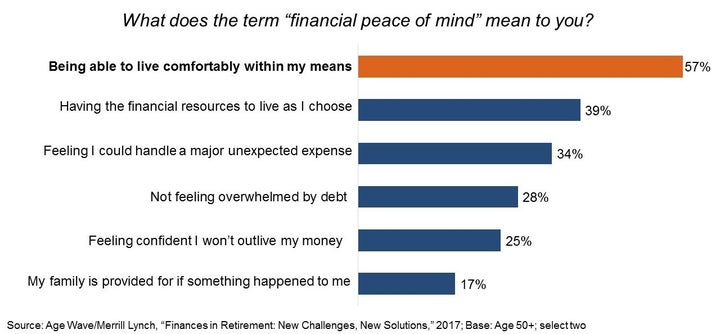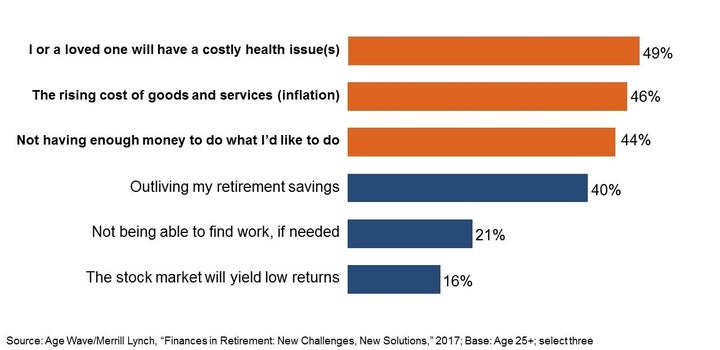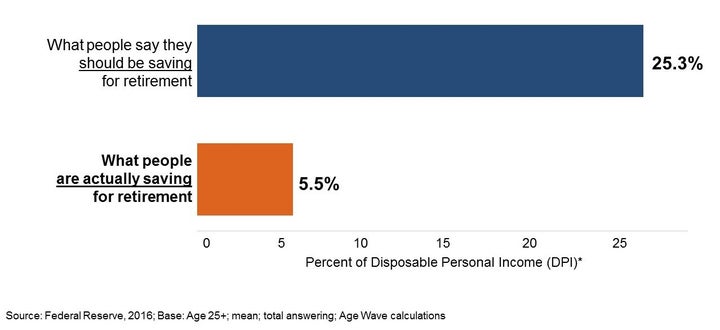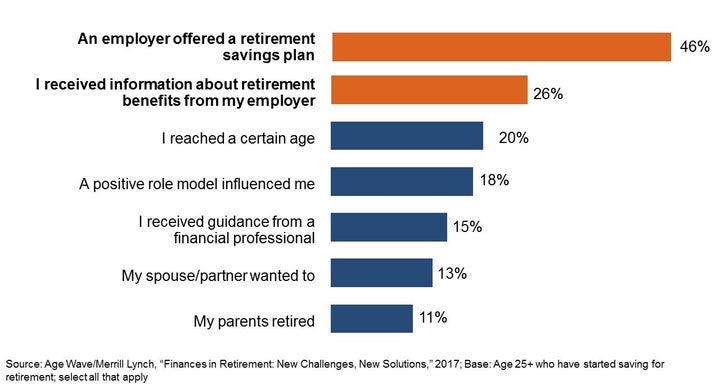
By Ken and Maddy Dychtwald
Are you ready to proactively help your future-self enjoy a happy, satisfying, and secure retirement? If so, the findings from our just completed study, Finances in Retirement: New Challenges, New Solutions, are a good place to start.
This is the capstone study of a four-year, 50,000-respondent, in-depth investigation into the changing lifescape of retirement. Our company, Age Wave, in partnership with Merrill Lynch, conducted a series of eight studies in total. Our goal was to view retirement holistically through seven interconnected, constantly changing life priorities: family, work, health, home, giving, leisure, and finances.
When seen as a whole, our studies portray a modern retirement with vast new freedoms and opportunities. Today’s retirees are more “time affluent” and more able to enjoy the lifestyle of their choosing. On the other hand, the massive wave of Boomer retirees, the rise in longevity, and the transformation of the retirement funding formula—away from employer pensions of the past—are creating new challenges. More Americans will need to fund longer retirements with more personal sources than ever before, and we’ll need to rethink our approach to do this successfully.
This article is the first of a two-part series in which we’ll explore some of the key findings from our new study. We will describe the hopes, dreams, worries, and priorities of Americans with regard to their finances in the years leading up to and through retirement. Tomorrow we’ll turn the corner to describe a wide spectrum of innovative solutions—specific course corrections, tradeoffs, and adjustments—you can make across all aspects of your life for a more personally satisfying and financially comfortable retirement. Some of them may surprise you and even motivate you to explore money-making and money-saving changes in your own life.
Seeking Financial Peace of Mind
Our study showed that for the overwhelming majority of Americans, the primary financial goal isn’t wealth per se; it’s peace of mind. Given the choice, seven times more people say they would like to save enough to have financial peace of mind.
But financial peace of mind can be elusive, and it can mean different things to different people. For the majority, we found it’s simply being able to live comfortably within one’s means. For most, it also includes the freedom to live as one chooses and the confidence to be able to handle an unexpected expense. (FIG 1)
FIGURE 1: What Financial Peace of Mind Means

Americans’ Biggest Worry
While peace of mind is the goal, our study also confirmed that finances are the #1 worry for most Americans, often impacting other areas of their life such as health, home, and family. In fact, finances and money are the common thread that impacts and intersects with every key area of our lives. When it comes to retirement, Americans of all ages worry that a financially secure retirement may be out of their reach. As one focus group participant explained, “The picture I always had in my mind of retirement was a carefree time with few worries or obligations. That just isn’t the case; and my number one worry: money. It keeps me up at night.”
When we asked people of all ages about their specific financial worries regarding retirement, the top three concerns were 1) a costly health issue impacting them or a loved one; 2) inflation—the rising cost of life, and 3) not having enough money to do what they want to do. (FIG 2)
FIGURE 2: Financial Worries in Retirement

Retirement: Life’s Biggest Expense
Compared to life’s other big expenses—buying a home, raising a child, paying for college—retirement carries THE highest average price tag, costing 2.5 times more than the average home. (FIG 3)
FIGURE 3: Retirement Has the Highest Price Tag

While most Americans understand that there’s a sizeable cost attached to retirement, 81% don’t know exactly how much they will need to retire comfortably. And for good reason.
The biggest unknown variable is how long each of us will live in retirement. The average life expectancy for a 65-year-old is now almost age 85, and is projected to continue to rise, but the average retirement age has remained at around age 63 for decades. When we asked Americans of all ages, “To what age would you like to live?” the average response was around 90 years. And older adults expressed the wish to live even longer.
Retiring at 65 and living to 90 means 25 years in retirement. Very few Americans say they are prepared for a retirement lasting that long. (FIG 4)
FIGURE 4: Ready for a Lengthy Retirement?

To complicate matters, while we’ll all need more funds for longer retirements, the old “three-legged stool” traditionally used to fund retirement—Social Security, employer pension, and personal savings—is getting wobbly. Most employers have discontinued defined benefits pensions in favor of 401(k)s and other forms of defined contribution programs. The result: funding retirement has evolved into a more personal responsibility. In our study, we found that Millennials expect 65% of their income in retirement to come from personal sources, versus the 26% needed by the Silent Generation.
Bridging the Intention-Action Gap
When it comes to retirement readiness, there’s lots of room for improvement. Our study participants seem to know what they should be doing to build retirement savings. They said they ought to 1) start saving early and 2) live within their means. And that’s precisely right. However, there’s a gap between intention and action, and people admit to saving far less than they think they should. On average, Americans say they think they should be saving about 25% of their disposable income (after taxes) each year. But the actual average annual savings rate in the U.S. is only 5.5%. (FIG 5) So Americans are saving less than a quarter of the amount they think they should be saving to fund their lengthening lives.
FIGURE 5: The Intention-Action Gap: Intended Versus Actual Savings Rates

There are good reasons for this. Namely, it’s hard to prioritize saving for your future-self when your present-self is trying to balance covering the cost of basic expenses and paying down debt, which our study participants listed as their biggest barriers to saving more for retirement.
Other complications fuel our financial worries as well. For one thing, talking about personal finances is still considered taboo. Fifty-seven percent of Americans consider their personal finances a private matter and only 8% feel they can be discussed openly. Although people feel comfortable discussing a wide range of personal issues with their best friends, 89% say they don’t know much about their best friend’s true financial situation. In fact, many people are more comfortable discussing their preferences for end of life than talking about their personal finances.
In addition, 65% of Americans say the language of finance is confusing and not user friendly. The encouraging news is that Americans recognize these challenges and want to find ways to improve their understanding of finances. Ninety percent say that basic financial management should be a standard part of school curriculum. We can’t think of any other subject on which 90% of Americans agree!
On the positive side, the study revealed that, by far, the most common trigger for saving for retirement is having an employer that offers a plan and provides information on how to take advantage of that plan. (FIG 6) It seems that people trust their employer regarding these matters more than anyone else. It’s also clear that there’s an important role employers can play in helping Americans fund their future-selves.
FIGURE 6: Triggers for Saving for Retirement

New Challenges, New Solutions
Given that millions of us will bear the responsibility of funding more of our own longevity than ever before, it’s clear we’ll need to find new triggers, motivations, and solutions to fund our future-selves. Most importantly, we’ll need to make this a priority.
As Lorna Sabbia, Head of Retirement & Personal Wealth Solutions at Merrill Lynch explained, “As Americans gear up for longer retirements, the responsibility for funding these later years is landing far more on their shoulders. Today’s retirees and future generations will need to play a more active role, which includes bridging the savings ‘intention-action’ gap, planning ahead to meet their retirement goals and regularly course correcting along the way.”
In tomorrow’s article, we will tie all this together holistically and show you how finance impacts and intersects with many aspects of your life from health to home, from work to family, from giving to leisure. We will share specific examples of tradeoffs, adjustments, and course corrections, and how each of us—no matter our circumstances, preferences, and goals—can pave a path to a more satisfying and financially secure retirement.
Want to Know More?
If you’d like to know more, please click here to view Ken giving a one hour multi-media keynote presentation on Re-Visioning Retirement and the seven Life Priorities.